Spring Cloud 入门
Spring Cloud 的学习是一个比较漫长的旅程。
参考博客资料:https://www.kuangstudy.com/bbs/1374942542566551554
1、学习前言
学习网站:
- SpringCloud Netflix 中文文档:https://springcloud.cc/spring-cloud-netflix.html
- SpringCloud 中文API文档(官方文档翻译版):https://springcloud.cc/spring-cloud-dalston.html
- SpringCloud中文网:https://springcloud.cc
1.1、模块预览
通过 springcloud, 我们可以实现的功能大致有:
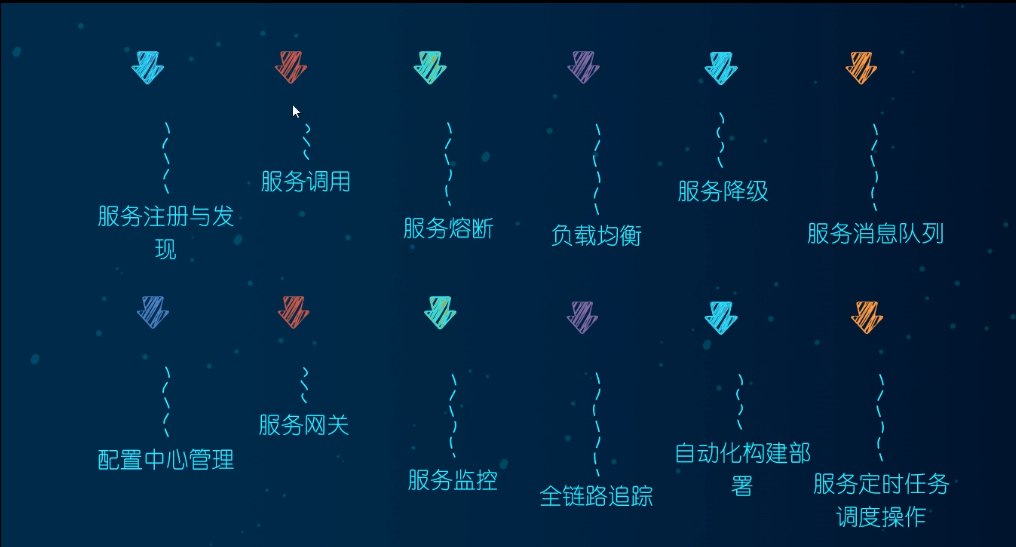
1.2、五大组件
- 服务注册与发现——Netflix Eureka
- 负载均衡:
- 客户端负载均衡——Netflix Ribbon
- 服务端负载均衡:——Feign(其也是依赖于Ribbon,只是将调用方式RestTemplete 更改成Service 接口)
- 断路器——Netflix Hystrix
- 服务网关——Netflix Zuul
- 分布式配置——Spring Cloud Config
2、微服务概述
2.1、什么是微服务?
什么是微服务?
微服务(Microservice Architecture) 是近几年流行的一种架构思想,关于它的概念很难一言以蔽之。
究竟什么是微服务呢?我们在此引用ThoughtWorks 公司的首席科学家 Martin Fowler 于2014年提出的一段话:
原文:https://martinfowler.com/articles/microservices.html
汉化:https://www.cnblogs.com/liuning8023/p/4493156.html
- 就目前而言,对于微服务,业界并没有一个统一的,标准的定义。
- 微服务架构是一种架构模式,它提倡将单一应用程序划分成一组小的服务,服务之间互相协调、互相配合,为用户提供最终价值。每个服务运行在其独立的进程中,服务与服务将采用轻量级的通信机制互相协作(通常是基于HTTP 协议的 RESTful API)。每个服务都围绕着具体业务进行构建,并且能够被独立的部署到生产环境等。另外,应当避免统一的、集中式的服务管理机制,对具体的一个服务而言,应根据业务上下文,选择合适的语言、工具对其进行构建。
再来从技术维度角度理解下:
- 微服务化的核心就是将传统的一站式应用,根据业务拆分成一个一个的服务,彻底地去耦合,每一个微服务提供单个业务功能的服务,一个服务做一件事情,从技术角度看就是一种小而独立的处理过程,类似进程的概念,能够自行单独启动或销毁,拥有自己独立的数据库。
2.2 、微服务优缺点
优点
- 单一职责原则;
- 每个服务足够内聚,足够小,代码容易理解,这样能聚焦一个指定的业务功能或业务需求;
- 开发简单,开发效率高,一个服务可能就是专一的只干一件事;
- 微服务能够被小团队单独开发,这个团队只需2-5个开发人员组成;
- 微服务是松耦合的,是有功能意义的服务,无论是在开发阶段或部署阶段都是独立的;
- 微服务能使用不同的语言开发;
- 易于和第三方集成,微服务允许容易且灵活的方式集成自动部署,通过持续集成工具,如jenkins,Hudson,bamboo;
- 微服务易于被一个开发人员理解,修改和维护,这样小团队能够更关注自己的工作成果,无需通过合作才能体现价值;
- 微服务允许利用和融合最新技术;
- 微服务只是业务逻辑的代码,不会和HTML,CSS,或其他的界面混合;
- 每个微服务都有自己的存储能力,可以有自己的数据库,也可以有统一的数据库;
缺点
- 开发人员要处理分布式系统的复杂性;
- 多服务运维难度,随着服务的增加,运维的压力也在增大;
- 系统部署依赖问题;
- 服务间通信成本问题;
- 数据一致性问题;
- 系统集成测试问题;
- 性能和监控问题;
2.3、微服务技术栈有那些?
| 微服务技术条目 | 落地技术 |
|---|---|
| 服务开发 | SpringBoot、Spring、SpringMVC等 |
| 服务配置与管理 | Netfix公司的Archaius、阿里的Diamond等 |
| 服务注册与发现 | Eureka、Consul、Zookeeper等 |
| 服务调用 | Rest、PRC、gRPC |
| 服务熔断器 | Hystrix、Envoy等 |
| 负载均衡 | Ribbon、Nginx等 |
| 服务接口调用(客户端调用服务的简化工具) | Fegin等 |
| 消息队列 | Kafka、RabbitMQ、ActiveMQ等 |
| 服务配置中心管理 | SpringCloudConfig、Chef等 |
| 服务路由(API网关) | Zuul、Nacos等 |
| 服务监控 | Zabbix、Nagios、Metrics、Specatator等 |
| 全链路追踪 | Zipkin、Brave、Dapper等 |
| 数据流操作开发包 | SpringCloud Stream(封装与Redis,Rabbit,Kafka等发送接收消息) |
| 时间消息总栈 | SpringCloud Bus |
| 服务部署 | Docker、OpenStack、Kubernetes等 |
2.5、为什么选择SpringCloud作为微服务架构
| 功能点/服务框架 | Netflix/SpringCloud | Motan | gRPC | Thri t | Dubbo/DubboX |
|---|---|---|---|---|---|
| 功能定位 | 完整的微服务框架 | RPC框架,但整合了ZK或Consul,实现集群环境的基本服务注册发现 | RPC框架 | RPC框架 | 服务框架 |
| 支持Rest | 是,Ribbon支持多种可拔插的序列号选择 | 否 | 否 | 否 | 否 |
| 支持RPC | 否 | 是(Hession2) | 是 | 是 | 是 |
| 支持多语言 | 是(Rest形式) | 否 | 是 | 是 | 否 |
| 负载均衡 | 是(服务端zuul+客户端Ribbon),zuul-服务,动态路由,云端负载均衡Eureka(针对中间层服务器) | 是(客户端) | 否 | 否 | 是(客户端) |
| 配置服务 | Netfix Archaius,Spring Cloud Config Server 集中配置 | 是(Zookeeper提供) | 否 | 否 | 否 |
| 服务调用链监控 | 是(zuul),zuul提供边缘服务,API网关 | 否 | 否 | 否 | 否 |
| 高可用/容错 | 是(服务端Hystrix+客户端Ribbon) | 是(客户端) | 否 | 否 | 是(客户端) |
| 典型应用案例 | Netflix | Sina | |||
| 社区活跃程度 | 高 | 一般 | 高 | 一般 | 2017年后重新开始维护,之前中断了5年 |
| 学习难度 | 中等 | 低 | 高 | 高 | 低 |
| 文档丰富程度 | 高 | 一般 | 一般 | 一般 | 高 |
| 其他 | Spring Cloud Bus为我们的应用程序带来了更多管理端点 | 支持降级 | Netflix内部在开发集成gRPC | IDL定义 | 实践的公司比较多 |
3. SpringCloud入门概述
3.1、SpringCloud是什么?
Spring官网:https://spring.io/
这是官网的模块流程图:
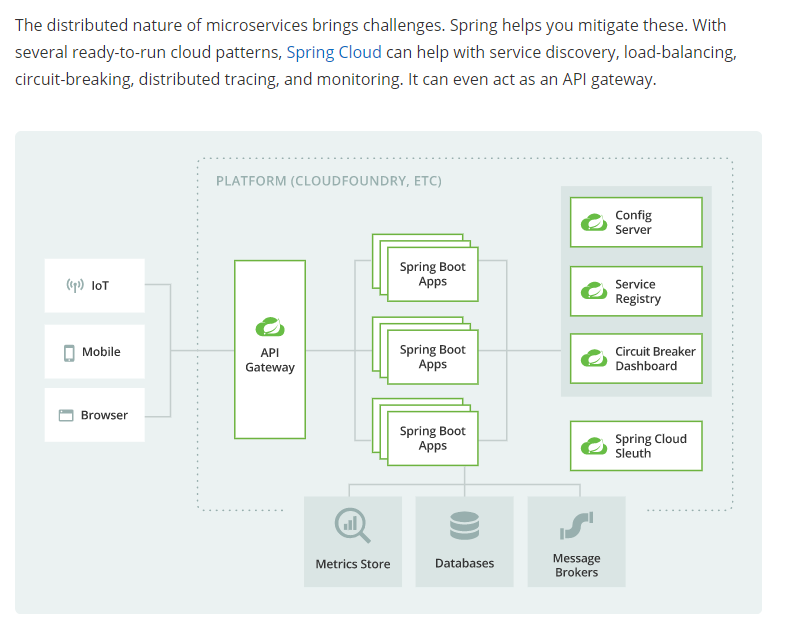
SpringCloud 是基于 SpringBoot 的一套微服务解决方案,巧妙地简化了分布式系统基础设施的开发,为开发人员提供了快速构建分布式系统的一些工具,包括配置管理,服务发现,断路器,路由,微代理,事件总线,全局锁,决策竞选,分布式会话等等,他们都可以用 SpringBoot 的开发风格做到一键启动和部署。
Spring Cloud 是分布式微服务架构下的一站式解决方案,是各个微服务架构落地技术的集合体,俗称微服务全家桶。
3.2、SpringCloud和SpringBoot的关系
- SpringBoot专注于开苏方便的开发单个个体微服务;
- SpringCloud是关注全局的微服务协调整理治理框架,它将SpringBoot开发的一个个单体微服务,整合并管理起来,为各个微服务之间提供:配置管理、服务发现、断路器、路由、为代理、事件总栈、全局锁、决策竞选、分布式会话等等集成服务;
- SpringBoot可以离开SpringCloud独立使用,开发项目,但SpringCloud离不开SpringBoot,属于依赖关系;
- SpringBoot专注于快速、方便的开发单个个体微服务,SpringCloud关注全局的服务治理框架;
3.3、Dubbo 和 SpringCloud技术选型
Dubbo 和 SpringCloud对比:
可以看一下社区活跃度:
https://github.com/spring-cloud
对比结果:
| Dubbo | SpringCloud | |
|---|---|---|
| 服务注册中心 | Zookeeper | Spring Cloud Netfilx Eureka |
| 服务调用方式 | RPC | REST API |
| 服务监控 | Dubbo-monitor | Spring Boot Admin |
| 断路器 | 不完善 | Spring Cloud Netfilx Hystrix |
| 服务网关 | 无 | Spring Cloud Netfilx Zuul |
| 分布式配置 | 无 | Spring Cloud Config |
| 服务跟踪 | 无 | Spring Cloud Sleuth |
| 消息总栈 | 无 | Spring Cloud Bus |
| 数据流 | 无 | Spring Cloud Stream |
| 批量任务 | 无 | Spring Cloud Task |
最大区别:Spring Cloud 抛弃了Dubbo的RPC通信,采用的是基于HTTP的REST方式
严格来说,这两种方式各有优劣。虽然从一定程度上来说,后者牺牲了服务调用的性能,但也避免了上面提到的原生RPC带来的问题。而且REST相比RPC更为灵活,服务提供方和调用方的依赖只依靠一纸契约,不存在代码级别的强依赖,这个优点在当下强调快速演化的微服务环境下,显得更加合适。
总结:二者解决的问题域不一样:Dubbo的定位是一款RPC框架,而SpringCloud的目标是微服务架构下的一站式解决方案。
3.4、SpringCloud能干嘛?
- Distributed/versioned configuration 分布式/版本控制配置
- Service registration and discovery 服务注册与发现
- Routing 路由
- Service-to-service calls 服务到服务的调用
- Load balancing 负载均衡配置
- Circuit Breakers 断路器
- Distributed messaging 分布式消息管理
- …
3.5、SpringCloud下载
官网:http://projects.spring.io/spring-cloud/

SpringCloud没有采用数字编号的方式命名版本号,而是采用了伦敦地铁站的名称,同时根据字母表的顺序来对应版本时间顺序,比如最早的Realse版本:Angel,第二个Realse版本:Brixto,然后是Camden、Dalston、Edgware,Hoxton最新的是 SR12 GA通用稳定版。
学习网站:
- SpringCloud Netflix 中文文档:https://springcloud.cc/spring-cloud-netflix.html
- SpringCloud 中文API文档(官方文档翻译版):https://springcloud.cc/spring-cloud-dalston.html
- SpringCloud中文网:https://springcloud.cc
4. SpringCloud Rest学习环境搭建:服务提供者
4.1 介绍
- 我们会使用一个Dept部门模块做一个微服务通用案例 Consumer 消费者(Client)通过REST调用 Provider 提供者(Server)提供的服务。
- 回顾 SpringMVC,Mybatis等以往学习的知识。
- Maven的分包分模块架构复习。
1. `一个简单的Maven模块结构是这样的:`
2. ``
3. `-- app-parent: 一个父项目(app-parent)聚合了很多子项目(app-utilapp-daoapp-web...)`
4. ` |-- pom.xml`
5. ` |`
6. ` |-- app-core`
7. ` ||---- pom.xml`
8. ` |`
9. ` |-- app-web`
10. ` ||---- pom.xml`
11. ` ......`
4.2 创建父工程
- 新建父工程项目springcloud,切记 Packageing 是 pom 模式。
- 主要是定义 POM 文件,将后续各个子模块公用的 jar 包等统一提取出来,类似一个抽象父类。
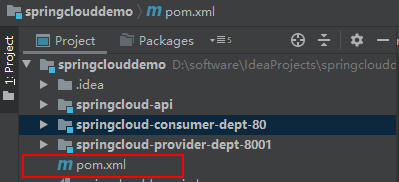
<modules>
<module>springcloud-api</module>
<module>springcloud-provider-dept-8001</module>
<module>springcloud-consumer-dept-80</module>
</modules>
<!--打包方式 pom-->
<packaging>pom</packaging>
<properties>
<project.build.sourceEncoding>UTF-8</project.build.sourceEncoding>
<maven.compiler.source>1.8</maven.compiler.source>
<maven.compiler.target>1.8</maven.compiler.target>
<junit.version>4.12</junit.version>
<log4j.version>1.2.17</log4j.version>
<lombok.version>1.16.18</lombok.version>
</properties>
<dependencyManagement>
<dependencies>
<!--spring cloud-->
<dependency>
<groupId>org.springframework.cloud</groupId>
<artifactId>spring-cloud-dependencies</artifactId>
<version>Hoxton.SR11</version>
<type>pom</type>
<scope>import</scope>
</dependency>
<!--兼容的springboot版本-->
<dependency>
<groupId>org.springframework.boot</groupId>
<artifactId>spring-boot-dependencies</artifactId>
<version>2.2.8</version>
<type>pom</type>
<scope>import</scope>
</dependency>
<!-- mysql驱动-->
<dependency>
<groupId>mysql</groupId>
<artifactId>mysql-connector-java</artifactId>
<version>8.0.21</version>
</dependency>
<!--druid-->
<dependency>
<groupId>com.alibaba</groupId>
<artifactId>druid</artifactId>
<version>1.2.6</version>
</dependency>
<!--mybatis-->
<dependency>
<groupId>org.mybatis.spring.boot</groupId>
<artifactId>mybatis-spring-boot-starter</artifactId>
<version>2.2.0</version>
</dependency>
<!--日志测试~-->
<dependency>
<groupId>ch.qos.logback</groupId>
<artifactId>logback-core</artifactId>
<version>1.2.3</version>
</dependency>
<dependency>
<groupId>junit</groupId>
<artifactId>junit</artifactId>
<version>${junit.version}</version>
</dependency>
<dependency>
<groupId>log4j</groupId>
<artifactId>log4j</artifactId>
<version>${log4j.version}</version>
</dependency>
<dependency>
<groupId>org.projectlombok</groupId>
<artifactId>lombok</artifactId>
<version>${lombok.version}</version>
</dependency>
</dependencies>
</dependencyManagement>
父工程为springcloud,其下有多个子mudule,如
- springcloud-provider-dept-8001 为服务提供者。
- springcloud-consumer-dept-80 为服务消费者。

4.3、服务提供者与消费者测试
springcloud-consumer-dept-80(服务提供者)访问 springcloud-provider-dept-8001(服务消费者) 下的 controller 使用 Restful 方式
服务提供者配置
springcloud-provider-dept-8001 为服务提供者,端口为8001,xml配置如下:
<dependencies>
<!--我们需要拿到实体类,所以要配置api module-->
<dependency>
<groupId>com.lin</groupId>
<artifactId>springcloud-api</artifactId>
<version>1.0-SNAPSHOT</version>
</dependency>
<!--mysql-->
<dependency>
<groupId>mysql</groupId>
<artifactId>mysql-connector-java</artifactId>
</dependency>
<!--druid-->
<dependency>
<groupId>com.alibaba</groupId>
<artifactId>druid</artifactId>
</dependency>
<!--mybatis-->
<dependency>
<groupId>org.mybatis.spring.boot</groupId>
<artifactId>mybatis-spring-boot-starter</artifactId>
</dependency>
<!--spring-web-->
<dependency>
<groupId>org.springframework.boot</groupId>
<artifactId>spring-boot-starter-web</artifactId>
</dependency>
<!--热部署-->
<dependency>
<groupId>org.springframework.boot</groupId>
<artifactId>spring-boot-devtools</artifactId>
</dependency>
</dependencies>
注意上文的 xml, springcloud-provider-dept-8001 的 dao 接口调用 springcloud-api 模块下的 pojo,可使用在 springcloud-provider-dept-8001 的 pom 文件导入 springcloud-api 模块依赖的方式:
<!--引入springcloud-api模块-->
<dependency>
<groupId>com.lin</groupId>
<artifactId>springcloud-api</artifactId>
<version>1.0-SNAPSHOT</version>
</dependency>
配置 application.yml:
server:
port: 8001
#mybatis
mybatis:
# 全类名
type-aliases-package: com.lin.springcloud.pojo
mapper-locations: classpath:mybatis/mapper/*.xml
# 驼峰命名
configuration:
map-underscore-to-camel-case: true
#spring
spring:
application:
name: spring-cloud-provider-dept
datasource:
type: com.alibaba.druid.pool.DruidDataSource
driver-class-name: com.mysql.cj.jdbc.Driver
url: jdbc:mysql://localhost:3306/spring_cloud_demo01?useUnicode=true&characterEncoding=utf-8&serverTimezone=GMT%2B8
username: root
password: 123456
编写 DeptProviderController:
/**
* 提供者,提供Restful服务
*/
@RequestMapping("/dept")
@RestController
public class DeptProviderController {
@Autowired
private DeptService deptService;
@PostMapping("/add")
public boolean addDept(@RequestBody Dept dept) {
return deptService.addDept(dept);
}
@GetMapping("/queryById/{id}")
public Dept queryById(@PathVariable("id") Long id) {
return deptService.queryById(id);
}
}
服务消费者配置
springcloud-consumer-dept-80 为服务消费者,端口为80,pom.xml 配置同服务提供者一样,这里忽略。
编写 DeptConsumerController,调用 DeptProviderController的接口:
/**
* 消费者
*/
@RequestMapping("/consumer")
@RestController
public class DeptConsumerController {
//提供多种便捷访问远程http服务的方法,简单的Restful服务模板
@Autowired
private RestTemplate restTemplate;
private static final String REST_URL_PREFIX = "http://localhost:8001";
@GetMapping("/add")
public Boolean get(Dept dept) {
return restTemplate.postForObject(REST_URL_PREFIX + "/dept/add", dept, Boolean.class);
}
@GetMapping("/queryById/{id}")
public Dept get(@PathVariable("id") Long id) {
return restTemplate.getForObject(REST_URL_PREFIX + "/dept/queryById/" + id, Dept.class);
}
}
需要装配 RestTemplate,编写 ConfigBean:
/**
* 装配Bean
*/
@Configuration
public class ConfigBean {
@Bean
public RestTemplate restTemplate() {
return new RestTemplate();
}
}
配置完毕,启动 springcloud-provider-dept-8001、springcloud-consumer-dept-80,访问服务消费者端口:
http://localhost/consumer/queryById/1 , 成功访问:

5、Eureka 服务注册与发现
5.1、什么是 Eureka
- Netflix 在涉及Eureka时,遵循的就是AP原则。
- Eureka 是 Netflix 的一个子模块,也是核心模块之一。Eureka 是基于 REST 的服务,用于定位服务,以实现云端中间件层服务发现和故障转移,服务注册与发现对于微服务来说是非常重要的,有了服务注册与发现,只需要使用服务的标识符,就可以访问到服务,而不需要修改服务调用的配置文件了,功能类似于Dubbo 的注册中心,比如 Zookeeper。
5.2、原理
Eureka基本的架构
- Springcloud 封装了 Netflix 公司开发的 Eureka 模块来实现服务注册与发现 (对比 Zookeeper)。
- Eureka 采用了 C-S 的架构设计,EurekaServer 作为服务注册功能的服务器,他是服务注册中心。
- 而系统中的其他微服务,使用 Eureka 的客户端连接到 EurekaServer 并维持心跳连接。这样系统的维护人员就可以通过 EurekaServer 来监控系统中各个微服务是否正常运行,Springcloud 的一些其他模块 (比如 Zuul ) 就可以通过 EurekaServer 来发现系统中的其他微服务,并执行相关的逻辑。
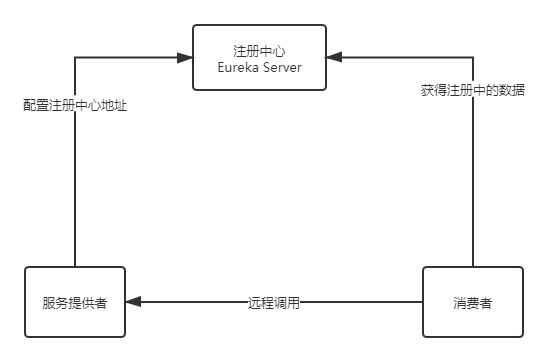
- Eureka 包含两个组件:Eureka Server 和 Eureka Client.
- Eureka Server 提供服务注册,各个节点启动后,回在EurekaServer 中进行注册,这样 Eureka Server 中的服务注册表中将会储存所有课用服务节点的信息,服务节点的信息可以在界面中直观的看到。
- Eureka Client 是一个Java客户端,用于简化 EurekaServer 的交互,客户端同时也具备一个内置的,使用轮询负载算法的负载均衡器。在应用启动后,将会向EurekaServer 发送心跳 (默认周期为30秒) 。如果 Eureka Server 在多个心跳周期内没有接收到某个节点的心跳,EurekaServer 将会从服务注册表中把这个服务节点移除掉 (默认周期为90秒)。
三大角色
- Eureka Server:提供服务的注册与发现。
- Service Provider:服务生产方,将自身服务注册到Eureka中,从而使服务消费方能狗找到。
- Service Consumer:服务消费方,从Eureka中获取注册服务列表,从而找到消费服务。
5.3 构建步骤
5.3.1、eureka-server
01、springcloud-eureka-7001 模块建立
02、pom.xml 配置:
<!--eureka-->
<dependency>
<groupId>org.springframework.cloud</groupId>
<artifactId>spring-cloud-starter-netflix-eureka-server</artifactId>
<version>2.2.8.RELEASE</version>
</dependency>
03、application.yml 配置:
server:
port: 7001
# eureka
eureka:
instance:
hostname: localhost # eureka服务端的实例名称
client:
register-with-eureka: false # 表示是否向eureka注册中心注册自己
fetch-registry: false # false则表示自己为注册中心
service-url: # 监控页面
defaultZone: http://${eureka.instance.hostname}:${server.port}/eureka/
查看源码,可以知道 Eureka 的默认端口和访问路径:

04、启动类添加 @EnableEurekaServer 注解:
@SpringBootApplication
@EnableEurekaServer //eureka的启动类,可以接受别人注册进来
public class EurekaServer_7001Application {
public static void main(String[] args) {
SpringApplication.run(EurekaServer_7001Application.class, args);
}
}
启动成功后访问 http://localhost:7001/ 得到以下页面:
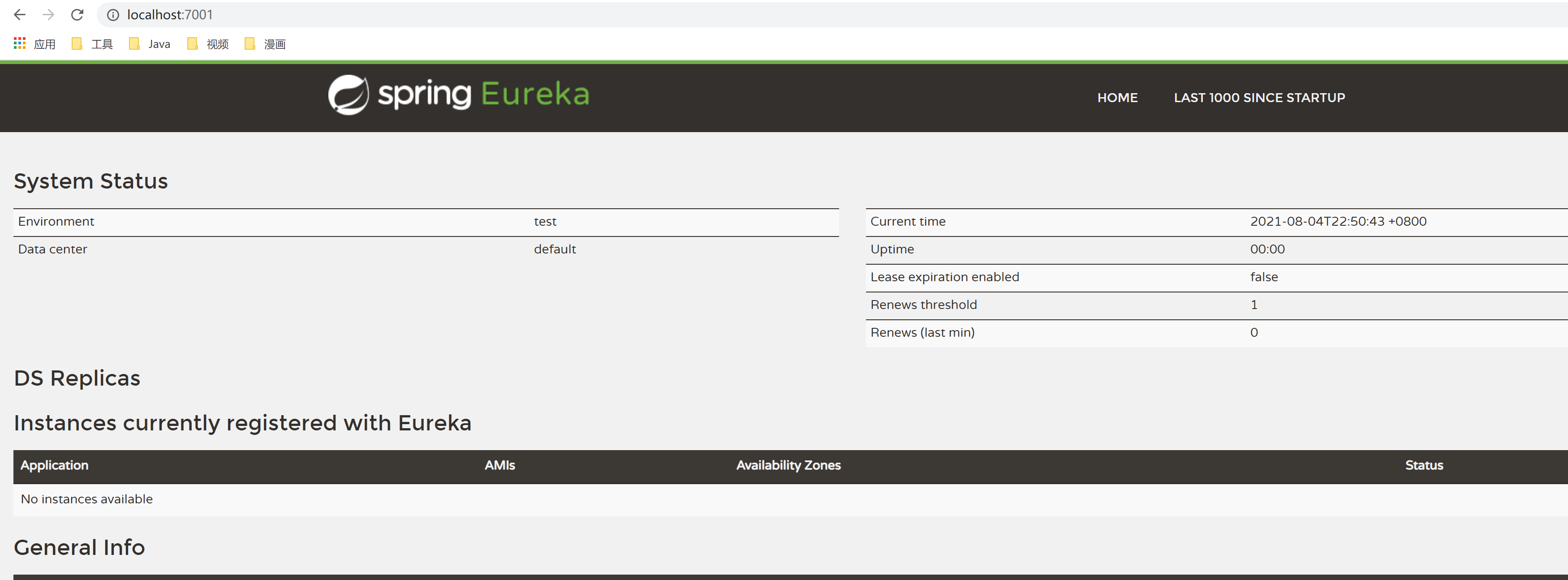
5.3.2、eureka-client
调整之前创建的springlouc-provider-dept-8001
01、导入 eureka 依赖:
<!--eureka-->
<dependency>
<groupId>org.springframework.cloud</groupId>
<artifactId>spring-cloud-starter-netflix-eureka-client</artifactId>
<version>2.2.8.RELEASE</version>
</dependency>
02、application 添加 eureka 配置:
#eureka 配置服务注册中心地址
eureka:
client:
service-url:
defaultZone: http://localhost:7001/eureka/
03、启动类添加 @EnableEurekaClient 注解:
@SpringBootApplication
//Eureka客户端注解,在服务启动后自动向注册中心注册服务
@EnableEurekaClient
public class DeptProvider_8001Application {
public static void main(String[] args) {
SpringApplication.run(DeptProvider_8001Application.class, args);
}
}
启动成功后,同样访问 http://localhost:7001/,可以发现服务已经注册进来了:

可以对注册进来的服务重命名,yml 修改配置:
#eureka 配置服务注册中心地址
eureka:
client:
service-url:
defaultZone: http://localhost:7001/eureka/
instance:
instance-id: spring-cloud-provider-dept8001 #修改eureka上的描述信息
如果此时停掉springcloud-provider-dept-8001,有可能需要等待 30s, 监控会开启保护机制:

配置关于服务加载的监控信息
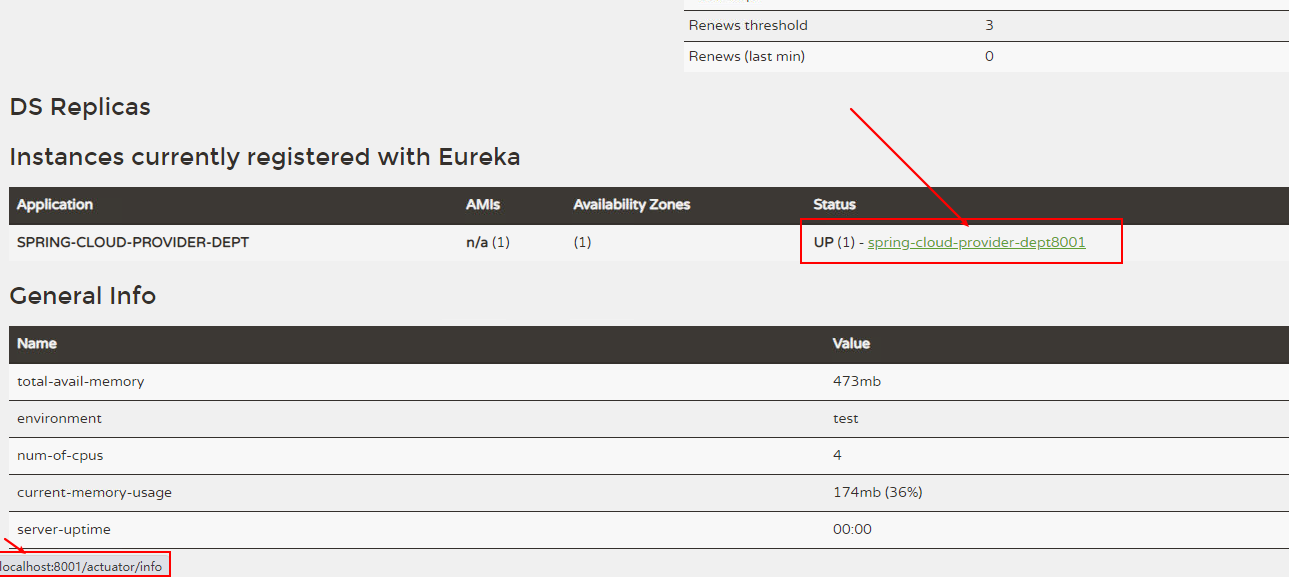
spring-cloud-provider-dept-8001 的 pom.xml 中添加依赖:
<!--actuator,完善监控信息-->
<dependency>
<groupId>org.springframework.boot</groupId>
<artifactId>spring-boot-starter-actuator</artifactId>
</dependency>
application.yml 添加 info配置, info 信息自定义:
# actuator info配置
info:
user.name: linxiansheng
email: 20271@qq.com
刷新监控页,点击 spring-cloud-provider-dept8001,跳转新页面,返回数据:

5.3.3、EureKa自我保护机制
某时刻某一个微服务不可用,eureka不会立即清理,依旧会对该微服务的信息进行保存!
详细内容可以参考下这篇博客内容:https://blog.csdn.net/wudiyong22/article/details/80827594
5.3.4、服务发现
springcloud-provider-dept-8001 即 eureka 客户端,相应 DeptProviderController 添加代码:
//注册进来的微服务,获取一些信息
@Autowired
private DiscoveryClient discoveryClient;
@GetMapping("/discovery")
public Object discovery() {
//得到微服务列表的清单
List<String> services = discoveryClient.getServices();
System.out.println("discovery=>services:" + services);
//得到一个具体的微服务信息,通过具体的微服务id:spring.application.name
List<ServiceInstance> instances = discoveryClient.getInstances("SPRING-CLOUD-PROVIDER-DEPT");
for (ServiceInstance instance : instances) {
System.out.println(
instance.getHost() + " " +
instance.getPort() + " " +
instance.getUri() + " " +
instance.getServiceId()
);
}
return this.discoveryClient;
}
启动类添加注解 @EnableDiscoveryClient 注解:
@SpringBootApplication
//Eureka客户端注解,在服务启动后自动向注册中心注册服务
@EnableEurekaClient
//服务发现
@EnableDiscoveryClient
public class DeptProvider_8001Application {
public static void main(String[] args) {
SpringApplication.run(DeptProvider_8001Application.class, args);
}
}
结果如下图:

控制台:

5.4、Eureka 集群环境配置
7001下注册7002、7003;7002下注册7001、7003等等。
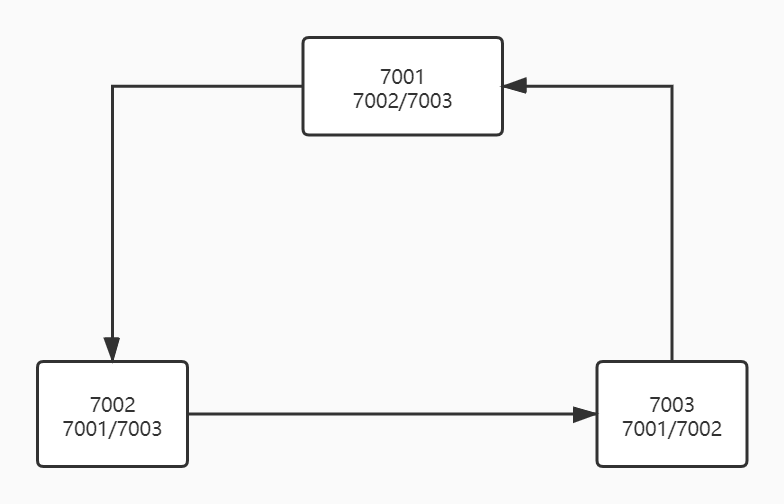
新建 springcloud-eureka-7002、springcloud-eureka-7003 模块
集群后的服务调用示例如下:

1、初始化
1.为 pom.xml 添加依赖 (与 springcloud-eureka-7001 相同)
<dependencies>
<!--eureka-->
<dependency>
<groupId>org.springframework.cloud</groupId>
<artifactId>spring-cloud-starter-netflix-eureka-server</artifactId>
<version>2.2.8.RELEASE</version>
</dependency>
<!--热部署-->
<dependency>
<groupId>org.springframework.boot</groupId>
<artifactId>spring-boot-devtools</artifactId>
</dependency>
</dependencies>
2.application.yml 配置(与 springcloud-eureka-7001 相同)
server:
port: 7002
# eureka
eureka:
instance:
hostname: localhost # eureka服务端的实例名称
client:
register-with-eureka: false # 表示是否向eureka注册中心注册自己
fetch-registry: false # false则表示自己为注册中心
service-url: # 监控页面
defaultZone: http://${eureka.instance.hostname}:${server.port}/eureka/
3.主启动类(与 springcloud-eureka-7001 相同)
@SpringBootApplication
@EnableEurekaServer //eureka的启动类,可以接受别人注册进来
public class EurekaServer_7002Application {
public static void main(String[] args) {
SpringApplication.run(EurekaServer_7002Application.class, args);
}
}
2、集群成员相互关联
配置一些自定义本机名字,找到本机hosts文件并打开,
在hosts文件最后加上,要访问的本机名称,默认是localhost。
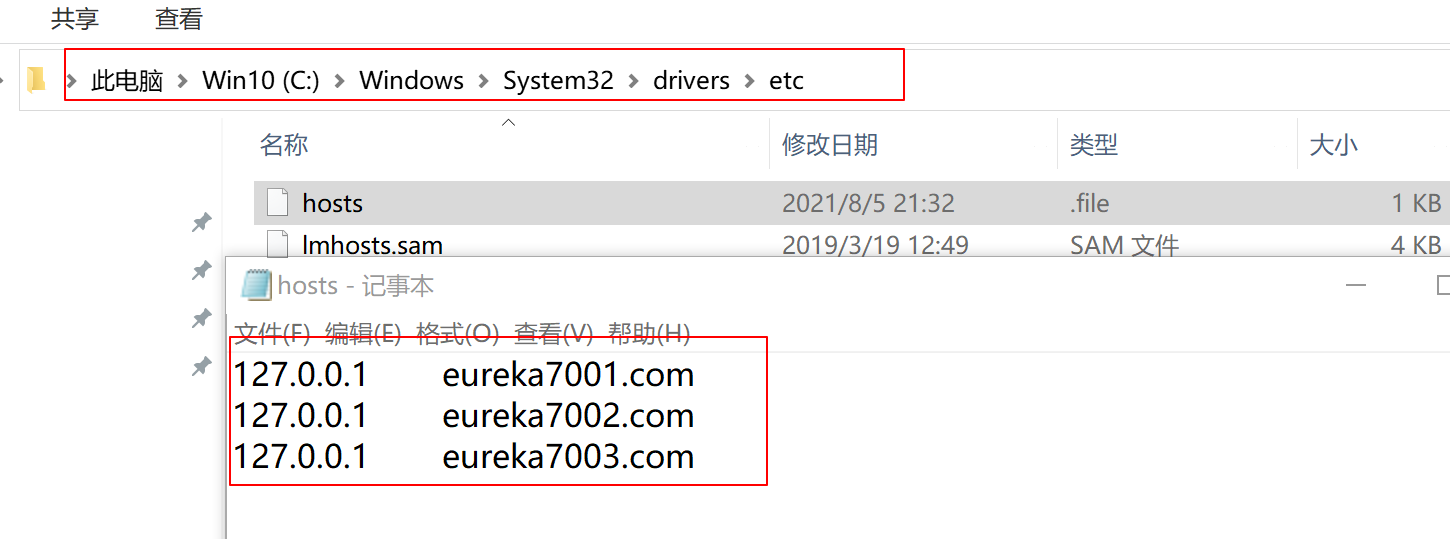
在集群中使 springcloud-eureka-7001 关联 springcloud-eureka-7002、springcloud-eureka-7003
完整的 springcloud-eureka-7001下的 application.yml 如下:
server:
port: 7001
# eureka
eureka:
instance:
hostname: eureka7001.com # eureka服务端的实例名称
client:
register-with-eureka: false # 表示是否向eureka注册中心注册自己
fetch-registry: false # false则表示自己为注册中心
service-url: # 监控页面
# defaultZone: http://${eureka.instance.hostname}:${server.port}/eureka/ # 单机
defaultZone: http://eureka7002.com:7002/eureka/,http://eureka7003.com:7003/eureka/ #集群,7001关联7002、7003
springcloud-eureka-7002、springcloud-eureka-7003 配置方式同理可得。
修改 springcloud-provider-dept-8001下的 yml 配置文件,修改 Eureka 配置:配置服务注册中心地址
#eureka 配置服务注册中心地址
eureka:
client:
service-url:
# 注册中心地址7001、7002、7003
defaultZone: http://eureka7001.com:7001/eureka/,http://eureka7002.com:7002/eureka/,http://eureka7003.com:7003/eureka/
instance:
instance-id: spring-cloud-provider-dept8001 #修改eureka上的描述信息
这样模拟集群就搭建好了,就可以把一个项目挂载到三个服务器上了

5.5 对比和 Zookeeper 区别
5.5.1、回顾CAP原则
RDBMS (MySQLOraclesqlServer) ===> ACID
NoSQL (RedisMongoDB) ===> CAP
5.5.2、ACID是什么?
- A (Atomicity) 原子性
- C (Consistency) 一致性
- I (Isolation) 隔离性
- D (Durability) 持久性
5.5.3、CAP是什么?
- C (Consistency) 一致性
- A (Availability) 可用性
- P (Partition tolerance) 分区容错性
5.5.4、CAP理论的核心
- 一个分布式系统不可能同时很好的满足一致性,可用性和分区容错性这三个需求
- 根据 CAP 原理,将 NoSQL 数据库分成了满足 CA 原则,满足 CP 原则和满足 AP 原则三大类
- CA:单点集群,满足一致性,可用性的系统,通常可扩展性较差
- CP:满足一致性,分区容错的系统,通常性能不是特别高
- AP:满足可用性,分区容错的系统,通常可能对一致性要求低一些
5.5.5、作为分布式服务注册中心,Eureka比Zookeeper好在哪里?
著名的CAP理论指出,一个分布式系统不可能同时满足C (一致性) 、A (可用性) 、P (容错性),由于分区容错性P再分布式系统中是必须要保证的,因此我们只能再A和C之间进行权衡。
- Zookeeper 保证的是 CP —> 满足一致性,分区容错的系统,通常性能不是特别高
- Eureka 保证的是 AP —> 满足可用性,分区容错的系统,通常可能对一致性要求低一些
Zookeeper 保证的是 CP
当向注册中心查询服务列表时,我们可以容忍注册中心返回的是几分钟以前的注册信息,但不能接收服务直接down 掉不可用。也就是说,服务注册功能对可用性的要求要高于一致性。但 zookeeper 会出现这样一种情况,当 master 节点因为网络故障与其他节点失去联系时,剩余节点会重新进行 leader 选举。问题在于,选举 leader的时间太长,30-120s,且选举期间整个 zookeeper 集群是不可用的,这就导致在选举期间注册服务瘫痪。在云部署的环境下,因为网络问题使得 zookeeper 集群失去 master 节点是较大概率发生的事件,虽然服务最终能够恢复,但是,漫长的选举时间导致注册长期不可用,是不可容忍的。
Eureka 保证的是 AP
Eureka 看明白了这一点,因此在设计时就优先保证可用性。Eureka 各个节点都是平等的,几个节点挂掉不会影响正常节点的工作,剩余的节点依然可以提供注册和查询服务。而 Eureka 的客户端在向某个 Eureka 注册时,如果发现连接失败,则会自动切换至其他节点,只要有一台 Eureka 还在,就能保住注册服务的可用性,只不过查到的信息可能不是最新的,除此之外,Eureka 还有之中自我保护机制,如果在15分钟内超过85%的节点都没有正常的心跳,那么 Eureka 就认为客户端与注册中心出现了网络故障,此时会出现以下几种情况:
- Eureka 不在从注册列表中移除因为长时间没收到心跳而应该过期的服务
- Eureka 仍然能够接受新服务的注册和查询请求,但是不会被同步到其他节点上 (即保证当前节点依然可用)
- 当网络稳定时,当前实例新的注册信息会被同步到其他节点中
因此,Eureka可以很好的应对因网络故障导致部分节点失去联系的情况,而不会像 zookeeper 那样使整个注册服务瘫痪
6、Ribbon:负载均衡(基于客户端)
6.1、负载均衡以及 Ribbon
Ribbon是什么?
- Spring Cloud Ribbon 是基于Netflix Ribbon 实现的一套客户端负载均衡的工具。
- 简单的说,Ribbon 是 Netflix 发布的开源项目,主要功能是提供客户端的软件负载均衡算法,将 Netflix 的中间层服务连接在一起。Ribbon 的客户端组件提供一系列完整的配置项,如:连接超时、重试等。简单的说,就是在配置文件中列出 LoadBalancer (简称LB:负载均衡) 后面所有的机器,Ribbon 会自动的帮助你基于某种规则 (如简单轮询,随机连接等等) 去连接这些机器。我们也容易使用 Ribbon 实现自定义的负载均衡算法!
负载均衡简单分类:
- 集中式LB
- 即在服务的提供方和消费方之间使用独立的LB设施,如Nginx(反向代理服务器),由该设施负责把访问请求通过某种策略转发至服务的提供方!
- 进程式 LB
- 将LB逻辑集成到消费方,消费方从服务注册中心获知有哪些地址可用,然后自己再从这些地址中选出一个合适的服务器。
- Ribbon 就属于进程内LB,它只是一个类库,集成于消费方进程,消费方通过它来获取到服务提供方的地址!
6.2、集成 Ribbon
在上文中,springcloud-consumer-dept-80 作为消费方,这里也作为 eureka 的客户端进行 Ribbon 的配置。
eureka 已经集成了 Ribbon,因此不需要再额外导入 Ribbon 的包:
<!--eureka-->
<dependency>
<groupId>org.springframework.cloud</groupId>
<artifactId>spring-cloud-starter-netflix-eureka-client</artifactId>
<version>2.2.8.RELEASE</version>
</dependency>
application.yml 配置:
#eureka 配置服务注册中心地址
eureka:
client:
service-url:
#注册中心地址7001、7002、7003
defaultZone: http://eureka7001.com:7001/eureka/,http://eureka7002.com:7002/eureka/,http://eureka7003.com:7003/eureka/
#不向注册中心注册自己
register-with-eureka: false
instance:
instance-id: spring-cloud-provider-dept8001 #修改eureka上的描述信息
启动类 添加 @EnableEurekaClient 注解,表示为 eureka 的客户端:
@SpringBootApplication
@EnableEurekaClient
public class DeptConsumer_80Application {
public static void main(String[] args) {
SpringApplication.run(DeptConsumer_80Application.class, args);
}
}
ConfigBean.java 配置 Ribbon 负载均衡实现 RestTemplate:
/**
* 装配Bean
*/
@Configuration
public class ConfigBean {
@Bean
//Ribbon 客户端负载均衡
@LoadBalanced
public RestTemplate restTemplate() {
return new RestTemplate();
}
}
修改 DeptConsumerController :
// private static final String REST_URL_PREFIX = "http://localhost:8001";
//Ribbon负载均衡,请求地址是一个变量,应该通过注册中心的服务名来访问
private static final String REST_URL_PREFIX = "http://SPRING-CLOUD-PROVIDER-DEPT";
6.3、使用 Ribbon 实现负载均衡
流程图如下:
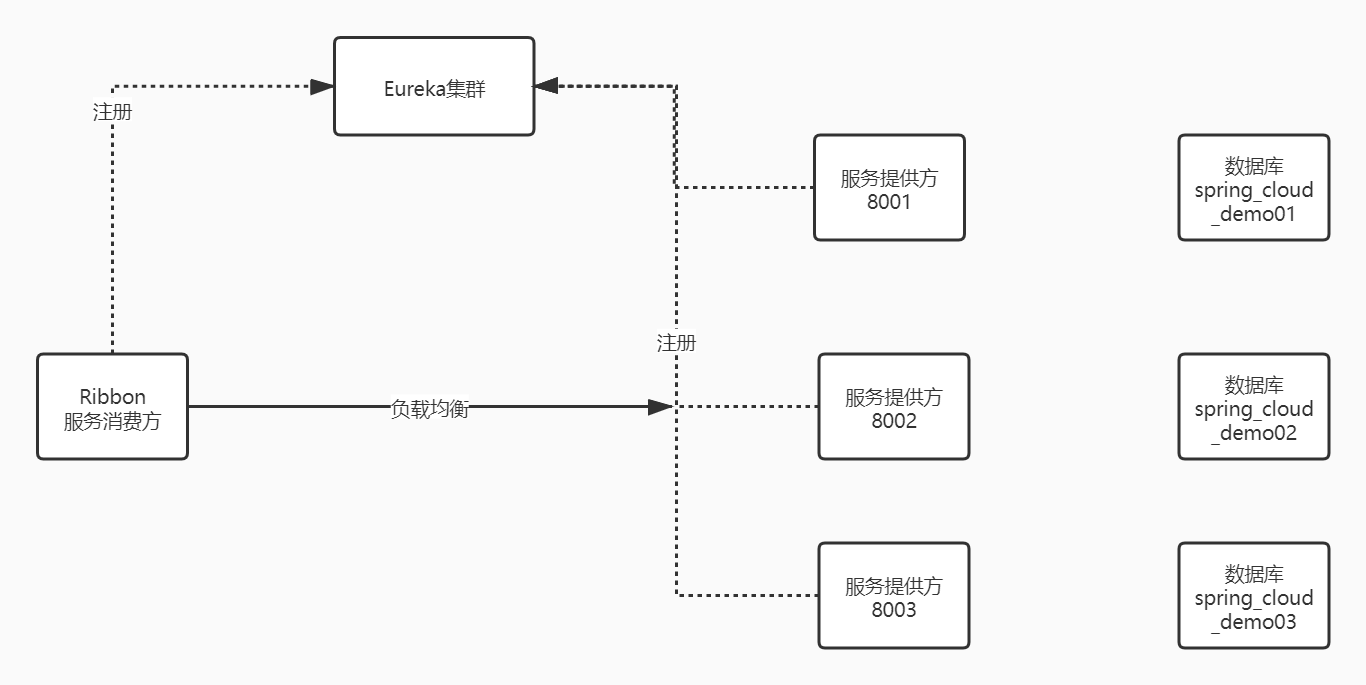
1.新建两个服务提供者Moudle:springcloud-provider-dept-8003、springcloud-provider-dept-8002
2.参照 springcloud-provider-dept-8001 依次为另外两个 Moudle 添加 pom.xml 依赖 、resourece 下的 mybatis 和 application.yml 配置,Java代码。
注意三个服务的名称要一致:
#spring
spring:
application:
name: spring-cloud-provider-dept #3个服务名称一致
以及 eureka 上服务的描述信息需要修改:
#eureka 配置服务注册中心地址
eureka:
client:
service-url:
# 注册中心地址7001、7002、7003
defaultZone: http://eureka7001.com:7001/eureka/,http://eureka7002.com:7002/eureka/,http://eureka7003.com:7003/eureka/
instance:
instance-id: spring-cloud-provider-dept8003 #修改eureka上的描述信息
3.启动所有服务测试(根据自身电脑配置决定启动服务的个数),访问 http://localhost:7001/ 查看结果

测试访问http://localhost/consumer/dept/queryById/1 这时候随机访问的是服务提供者 8001:

再次访问,访问的是服务提供者 8002:

第三次访问,访问的则是服务提供者 8003:

以上这种每次访问 http://localhost/consumer/queryById/1 随机访问集群中某个服务提供者,这种情况叫做轮询,轮询算法在SpringCloud中可以自定义。
如何切换规则呢?
在springcloud-provider-dept-80模块下的ConfigBean中进行配置,切换使用不同的规则
@Configuration
public class ConfigBean {
@Bean
//Ribbon 客户端负载均衡
@LoadBalanced
public RestTemplate restTemplate() {
return new RestTemplate();
}
/**
*
* 负载均衡策略
* @return
*/
@Bean
public IRule myRule() {
return new RandomRule();//使用随机策略
//return new RoundRobinRule();//使用轮询策略
//return new AvailabilityFilteringRule();//使用轮询策略
//return new RetryRule();//使用轮询策略
}
}
关于自定义规则请参考官方文档:https://www.springcloud.cc/spring-cloud-dalston.html#_customizing_the_ribbon_client
7、Feign:负载均衡(基于服务端)
7.1、Feign简介
Feign 是声明式 Web Service 客户端,它让微服务之间的调用变得更简单,类似 controller 调用 service。SpringCloud 集成了 Ribbon 和 Eureka,可以使用 Feigin 提供负载均衡的 http 客户端。
只需要创建一个接口,然后添加注解即可~
Feign,主要是社区版,大家都习惯面向接口编程。这个是很多开发人员的规范。调用微服务访问两种方法:
- 微服务名字 【ribbon】
- 接口和注解 【feign】
Feign能干什么?
-
Feign 旨在使编写 Java Http 客户端变得更容易
-
前面在使用 Ribbon + RestTemplate 时,利用 RestTemplate 对 http 请求的封装处理,形成了一套模板化的调用方法。但是在实际开发中,由于对服务依赖的调用可能不止一处,往往一个接口会被多处调用,所以通常都会针对每个微服务自行封装一个客户端类来包装这些依赖服务的调用。所以,Feign 在此基础上做了进一步的封装,由他来帮助我们定义和实现依赖服务接口的定义,在 Feign 的实现下,我们只需要创建一个接口并使用注解的方式来配置它 (类似以前 Dao 接口上标注 Mapper 注解,现在是一个微服务接口上面标注一个 Feign 注解),即可完成对服务提供方的接口绑定,简化了使用 Spring Cloud Ribbon 时,自动封装服务调用客户端的开发量。
-
利用 Ribbon 维护了 MicroServiceCloud-Dept 的服务列表信息,并且通过轮询实现了客户端的负载均衡,而与 Ribbon 不同的是,通过 Feign 只需要定义服务绑定接口且以声明式的方法,优雅而简单的实现了服务调用。
7.2、Feign的使用步骤
1、创建 springcloud-consumer-dept-feign 模块

拷贝 springcloud-consumer-dept-80 模块下的 pom.xml,resource,以及 java 代码到 springcloud-consumer-feign 模块,并添加 feign 依赖:
<!--feign-->
<dependency>
<groupId>org.springframework.cloud</groupId>
<artifactId>spring-cloud-starter-openfeign</artifactId>
<version>2.2.8.RELEASE</version>
</dependency>
修改 DeptConsumerController :
@RequestMapping("/consumer")
@RestController
public class DeptConsumerController {
//调用feign服务
@Autowired
private DeptClientService deptClientService;
@GetMapping("/add")
public Boolean get(Dept dept) {
return deptClientService.addDept(dept);
}
@GetMapping("/queryById/{id}")
public Dept get(@PathVariable("id") Long id) {
return deptClientService.queryById(id);
}
}
启动类配置如下:
@SpringBootApplication
@EnableEurekaClient
//feign客户端注解,并指定要扫描的包以及配置接口DeptClientService
@EnableFeignClients(basePackages = {"com.lin.springcloud"})
public class FeignDeptConsumer_80Application {
public static void main(String[] args) {
SpringApplication.run(FeignDeptConsumer_80Application.class, args);
}
}
2、改造 springcloud-api 模块
1、pom.xml 同样添加 feign 依赖:
<!--feign-->
<dependency>
<groupId>org.springframework.cloud</groupId>
<artifactId>spring-cloud-starter-openfeign</artifactId>
<version>2.2.8.RELEASE</version>
</dependency>
2、新建 service 包,并新建 DeptClientService.java 接口:
@Component
//微服务客户端注解,value:指定微服务的名字,这样就可以使Feign客户端直接找到对应的微服务
@FeignClient(value = "SPRING-CLOUD-PROVIDER-DEPT")
public interface DeptClientService {
@PostMapping("/dept/add")
boolean addDept(Dept dept);
@GetMapping("/dept/queryById/{id}")
Dept queryById(@PathVariable("id") Long id);
}
配置完成,启动 springcloud-dept-consumer-dept-feign ,访问接口成功:

8、Hystrix:服务熔断
分布式系统面临的问题
复杂分布式体系结构中的应用程序有数十个依赖关系,每个依赖关系在某些时候将不可避免失败!
8.1、服务雪崩
多个微服务之间调用的时候,假设微服务A调用微服务B和微服务C,微服务B和微服务C又调用其他的微服务,这就是所谓的“扇出”,如果扇出的链路上某个微服务的调用响应时间过长,或者不可用,对微服务A的调用就会占用越来越多的系统资源,进而引起系统崩溃,所谓的“雪崩效应”。
对于高流量的应用来说,单一的后端依赖可能会导致所有服务器上的所有资源都在几十秒内饱和。比失败更糟糕的是,这些应用程序还可能导致服务之间的延迟增加,备份队列,线程和其他系统资源紧张,导致整个系统发生更多的级联故障,这些都表示需要对故障和延迟进行隔离和管理,以达到单个依赖关系的失败而不影响整个应用程序或系统运行。
8.2、什么是 Hystrix?
Hystrix 是一个应用于处理分布式系统的延迟和容错的开源库,在分布式系统里,许多依赖不可避免的会调用失败,比如超时,异常等,Hystrix 能够保证在一个依赖出问题的情况下,不会导致整个体系服务失败,避免级联故障,以提高分布式系统的弹性。
“断路器”本身是一种开关装置,当某个服务单元发生故障之后,通过断路器的故障监控 (类似熔断保险丝) ,向调用方返回一个服务预期的,可处理的备选响应 (FallBack) ,而不是长时间的等待或者抛出调用方法无法处理的异常,这样就可以保证了服务调用方的线程不会被长时间,不必要的占用,从而避免了故障在分布式系统中的蔓延,乃至雪崩。
8.3 Hystrix能干嘛?
- 服务降级
- 服务熔断
- 服务限流
- 接近实时的监控
- ...
官网资料:https://github.com/Netflix/Hystrix/wiki
当一切正常时,请求流可以如下所示:

当许多后端系统中有一个潜在阻塞服务时,它可以阻止整个用户请求:
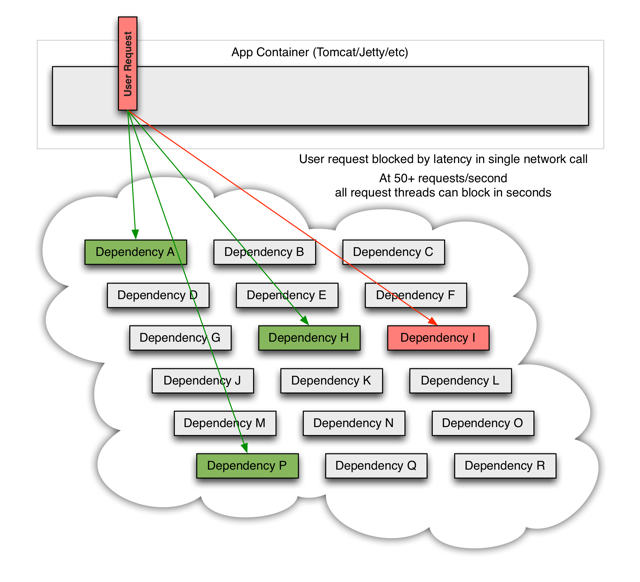
随着大容量通信量的增加,单个后端依赖项的潜在性会导致所有服务器上的所有资源在几秒钟内饱和。
应用程序中通过网络或客户端库可能导致网络请求的每个点都是潜在故障的来源。比失败更糟糕的是,这些应用程序还可能导致服务之间的延迟增加,从而备份队列、线程和其他系统资源,从而导致更多跨系统的级联故障。

当您使用 Hystrix 包装每个底层依赖项时,如上图所示的架构将更改为类似于下图。每个依赖项彼此隔离,限制在发生延迟时它可以饱和的资源,并覆盖在回退逻辑中,该逻辑决定在依赖项中发生任何类型的故障时做出什么响应:

8.4、服务熔断
什么是服务熔断?
熔断机制是赌赢雪崩效应的一种微服务链路保护机制。
当扇出链路的某个微服务不可用或者响应时间太长时,会进行服务的降级,进而熔断该节点微服务的调用,快速返回错误的响应信息。检测到该节点微服务调用响应正常后恢复调用链路。在 SpringCloud 框架里熔断机制通过 Hystrix 实现。Hystrix 会监控微服务间调用的状况,当失败的调用到一定阀值缺省是5秒内20次调用失败,就会启动熔断机制。熔断机制的注解是:@HystrixCommand。
服务熔断解决如下问题:
- 当所依赖的对象不稳定时,能够起到快速失败的目的;
- 快速失败后,能够根据一定的算法动态试探所依赖对象是否恢复。
案例演示
新建 springcloud-provider-dept-hystrix-8001 模块并拷贝 springcloud-provider-dept–8001 内的 pom.xml、resource 和 Java 代码进行初始化并调整。
导入 hystrix 依赖:
<!--hystrix-->
<dependency>
<groupId>org.springframework.cloud</groupId>
<artifactId>spring-cloud-starter-netflix-hystrix</artifactId>
<version>2.2.8.RELEASE</version>
</dependency>
application.yml 配置:
server:
port: 8001
#mybatis
mybatis:
# 全类名
type-aliases-package: com.lin.springcloud.pojo
mapper-locations: classpath:mybatis/mapper/*.xml
# 驼峰命名
configuration:
map-underscore-to-camel-case: true
#spring
spring:
application:
name: spring-cloud-provider-dept
datasource:
type: com.alibaba.druid.pool.DruidDataSource
driver-class-name: com.mysql.cj.jdbc.Driver
url: jdbc:mysql://localhost:3306/spring_cloud_demo01?useUnicode=true&characterEncoding=utf-8&serverTimezone=GMT%2B8
username: root
password: 123456
#eureka 配置服务注册中心地址
eureka:
client:
service-url:
# 注册中心地址7001、7002、7003
defaultZone: http://eureka7001.com:7001/eureka/,http://eureka7002.com:7002/eureka/,http://eureka7003.com:7003/eureka/
instance:
instance-id: spring-cloud-provider-dept-hystrix-8001 #修改eureka上的描述信息
# actuator info配置
info:
user.name: linxiansheng
email: 20271@qq.com
修改 Controller :
/**
* 提供者,提供Restful服务
*/
@RequestMapping("/dept")
@RestController
public class DeptProviderController {
@Autowired
private DeptService deptService;
/**
* 根据id查询
* 如果根据id查询出现异常,则走hystrixGet这段备选代码
* @param id
* @return
*/
@GetMapping("/queryById/{id}")
@HystrixCommand(fallbackMethod = "hystrixGet")
public Dept queryById(@PathVariable("id") Long id) {
Dept dept = deptService.queryById(id);
if (dept == null) {
throw new RuntimeException("id=>" + id + "不存在该部门");
}
return dept;
}
//备选方法
public Dept hystrixGet(@PathVariable("id") Long id) {
return new Dept().setId(id).
setName("id=>" + id + "没有对应的部门")
.setDbSource("no this database in MySQL");
}
}
启动类添加对熔断的支持注解 @EnableHystrix
@SpringBootApplication//Eureka客户端注解,在服务启动后自动向注册中心注册服务@EnableEurekaClient//服务发现@EnableDiscoveryClient//对服务熔断的支持@EnableHystrixpublic class DeptProviderHystrix_8001Application { public static void main(String[] args) { SpringApplication.run(DeptProviderHystrix_8001Application.class, args); }}
测试:
使用熔断后,当访问一个不存在的id时,前台页展示数据如下:

说明服务熔断成功了。
8.5、服务降级
什么是服务降级?
服务降级是指 当服务器压力剧增的情况下,根据实际业务情况及流量,对一些服务和页面有策略的不处理,或换种简单的方式处理,从而释放服务器资源以保证核心业务正常运作或高效运作。说白了,就是尽可能的把系统资源让给优先级高的服务。
资源有限,而请求是无限的。如果在并发高峰期,不做服务降级处理,一方面肯定会影响整体服务的性能,严重的话可能会导致宕机某些重要的服务不可用。所以,一般在高峰期,为了保证核心功能服务的可用性,都要对某些服务降级处理。比如当双11活动时,把交易无关的服务统统降级,如查看蚂蚁深林,查看历史订单等等。
服务降级主要用于什么场景呢?当整个微服务架构整体的负载超出了预设的上限阈值或即将到来的流量预计将会超过预设的阈值时,为了保证重要或基本的服务能正常运行,可以将一些 不重要 或 不紧急 的服务或任务进行服务的 延迟使用 或 暂停使用。
降级的方式可以根据业务来,可以延迟服务,比如延迟给用户增加积分,只是放到一个缓存中,等服务平稳之后再执行 ;或者在粒度范围内关闭服务,比如关闭相关文章的推荐。
服务降级需要考虑的问题
- 1)那些服务是核心服务,哪些服务是非核心服务。
- 2)那些服务可以支持降级,那些服务不能支持降级,降级策略是什么
- 3)除服务降级之外是否存在更复杂的业务放通场景,策略是什么?
自动降级分类
1)超时降级:主要配置好超时时间和超时重试次数和机制,并使用异步机制探测回复情况。
2)失败次数降级:主要是一些不稳定的api,当失败调用次数达到一定阀值自动降级,同样要使用异步机制探测回复情况。
3)故障降级:比如要调用的远程服务挂掉了(网络故障、DNS故障、http服务返回错误的状态码、rpc服务抛出异常),则可以直接降级。降级后的处理方案有:默认值(比如库存服务挂了,返回默认现货)、兜底数据(比如广告挂了,返回提前准备好的一些静态页面)、缓存(之前暂存的一些缓存数据)。
4)限流降级:秒杀或者抢购一些限购商品时,此时可能会因为访问量太大而导致系统崩溃,此时会使用限流来进行限制访问量,当达到限流阀值,后续请求会被降级;降级后的处理方案可以是:排队页面(将用户导流到排队页面等一会重试)、无货(直接告知用户没货了)、错误页(如活动太火爆了,稍后重试)。
案例演示
在 springcloud-api 模块下的 service 包中新建降级配置类 DeptClientServiceFallBackFactory.java
/**
* 服务降级
*/
@Component
public class DeptClientServiceFallbackFactory implements FallbackFactory {
@Override
public DeptClientService create(Throwable throwable) {
return new DeptClientService() {
@Override
public boolean addDept(Dept dept) {
return false;
}
@Override
public Dept queryById(Long id) {
return new Dept().setId(id)
.setName("id=>" + id + "客户端提供了降级的信息,服务已经被关闭")
.setDbSource("没有数据");
}
};
}
}
在 DeptClientService 中指定降级配置类 DeptClientServiceFallBackFactory
@Component
//微服务客户端注解,value:指定微服务的名字,这样就可以使Feign客户端直接找到对应的微服务
//fallbackFactory指定降级配置类
@FeignClient(value = "SPRING-CLOUD-PROVIDER-DEPT", fallbackFactory = DeptClientServiceFallbackFactory.class)
public interface DeptClientService {
@PostMapping("/dept/add")
boolean addDept(Dept dept);
@GetMapping("/dept/queryById/{id}")
Dept queryById(@PathVariable("id") Long id);
}
在 springcloud-consumer-dept-feign 模块中开启降级:
server:
port: 80
#eureka 配置服务注册中心地址
eureka:
client:
service-url:
#注册中心地址7001、7002、7003
defaultZone: http://eureka7001.com:7001/eureka/,http://eureka7002.com:7002/eureka/,http://eureka7003.com:7003/eureka/
#不向注册中心注册自己
register-with-eureka: false
instance:
instance-id: spring-cloud-provider-feign-dept80 #修改eureka上的描述信息
#开启feign.hystrix,支持服务降级
feign:
hystrix:
enabled: true
8.6、服务熔断和降级的区别
- 服务熔断—>服务端:某个服务超时或异常,引起熔断~,类似于保险丝(自我熔断)
- 服务降级—>客户端:从整体网站请求负载考虑,当某个服务熔断或者关闭之后,服务将不再被调用,此时在客户端,我们可以准备一个 FallBackFactory ,返回一个默认的值(缺省值)。会导致整体的服务下降,但是好歹能用,比直接挂掉强。
- 触发原因不太一样,服务熔断一般是某个服务(下游服务)故障引起,而服务降级一般是从整体负荷考虑;管理目标的层次不太一样,熔断其实是一个框架级的处理,每个微服务都需要(无层级之分),而降级一般需要对业务有层级之分(比如降级一般是从最外围服务开始)
- 实现方式不太一样,服务降级具有代码侵入性(由控制器完成/或自动降级),熔断一般称为自我熔断。
熔断,降级,限流:
限流:限制并发的请求访问量,超过阈值则拒绝;
降级:服务分优先级,牺牲非核心服务(不可用),保证核心服务稳定;从整体负荷考虑;
熔断:依赖的下游服务故障触发熔断,避免引发本系统崩溃;系统自动执行和恢复.
8.7、Dashboard 流量监控
新建 springcloud-consumer-hystrix-dashboard 模块
添加依赖
<dependencies>
<!--hystrix-dashboard-->
<dependency>
<groupId>org.springframework.cloud</groupId>
<artifactId>spring-cloud-starter-netflix-hystrix-dashboard</artifactId>
<version>2.2.8.RELEASE</version>
</dependency>
<!--实体类-->
<dependency>
<groupId>com.lin</groupId>
<artifactId>springcloud-api</artifactId>
<version>1.0-SNAPSHOT</version>
</dependency>
<!--spring-web-->
<dependency>
<groupId>org.springframework.boot</groupId>
<artifactId>spring-boot-starter-web</artifactId>
</dependency>
<!--热部署-->
<dependency>
<groupId>org.springframework.boot</groupId>
<artifactId>spring-boot-devtools</artifactId>
</dependency>
<!--eureka-->
<dependency>
<groupId>org.springframework.cloud</groupId>
<artifactId>spring-cloud-starter-netflix-eureka-client</artifactId>
<version>2.2.8.RELEASE</version>
</dependency>
</dependencies>
配置 application.yml:
server:
port: 9001
#eureka 配置服务注册中心地址
eureka:
client:
service-url:
#注册中心地址7001、7002、7003
defaultZone: http://eureka7001.com:7001/eureka/,http://eureka7002.com:7002/eureka/,http://eureka7003.com:7003/eureka/
#不向注册中心注册自己
register-with-eureka: false
hystrix:
dashboard:
proxy-stream-allow-list: "*"
启动类:
@SpringBootApplication//开启流量监控@EnableHystrixDashboardpublic class DeptConsumerDashboard_9001Application { public static void main(String[] args) { SpringApplication.run(DeptConsumerDashboard_9001Application.class); }}
接下来配置 springcloud-provider-dept-hystrix-8001 模块,pom.xml 增加依赖:
<!--hystrix-dashboard-->
<dependency>
<groupId>org.springframework.cloud</groupId>
<artifactId>spring-cloud-starter-netflix-hystrix-dashboard</artifactId>
<version>2.2.8.RELEASE</version>
</dependency>
启动类添加如下代码,添加监控:
@SpringBootApplication
//Eureka客户端注解,在服务启动后自动向注册中心注册服务
@EnableEurekaClient
//服务发现
@EnableDiscoveryClient
//对服务熔断的支持
@EnableHystrix
public class DeptProviderHystrix_8001Application {
public static void main(String[] args) {
SpringApplication.run(DeptProviderHystrix_8001Application.class, args);
}
//增加一个servlet
@Bean
public ServletRegistrationBean hystrixMetricsStreamServlet() {
ServletRegistrationBean registrationBean = new ServletRegistrationBean(new HystrixMetricsStreamServlet());
//访问该页面就是监控页面
registrationBean.addUrlMappings("/actuator/hystrix.stream");
return registrationBean;
}
}
访问:http://localhost:9001/hystrix
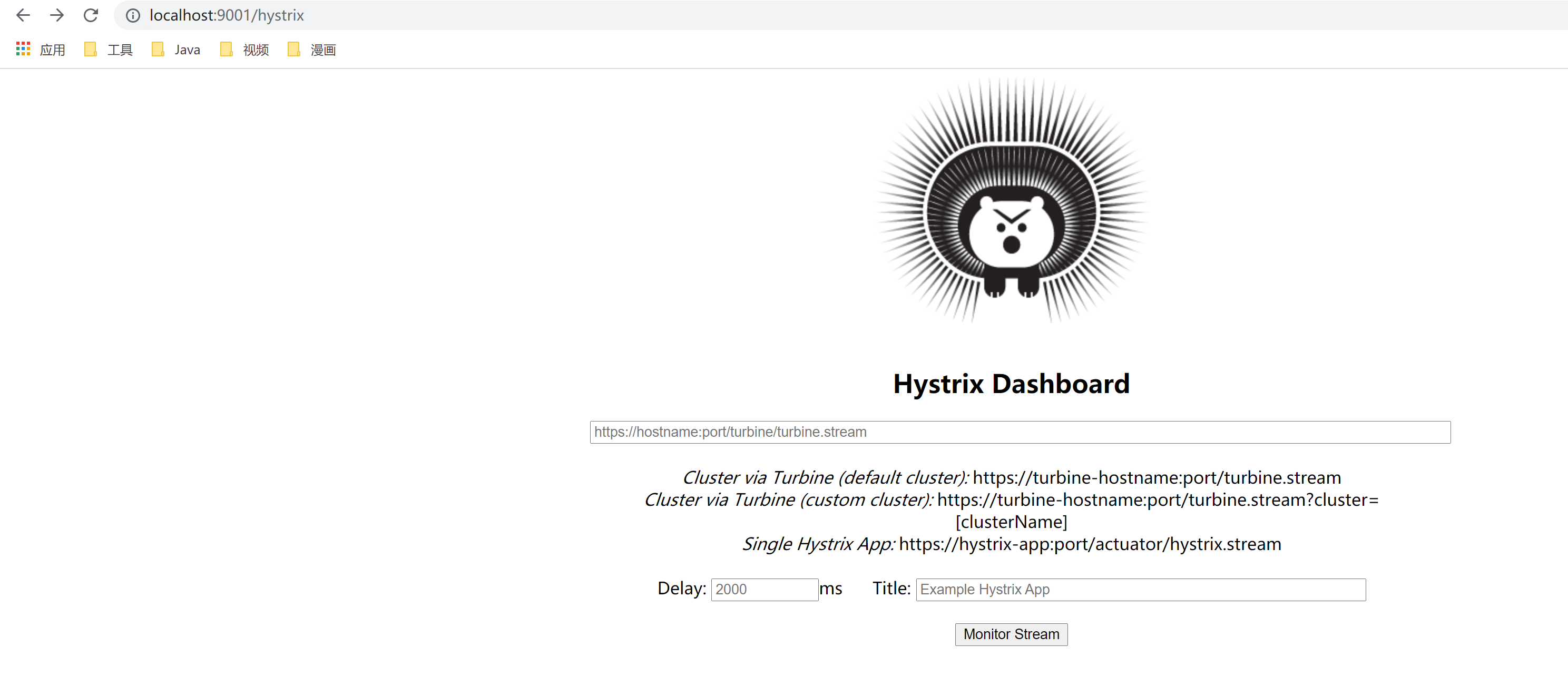
进入监控页面:
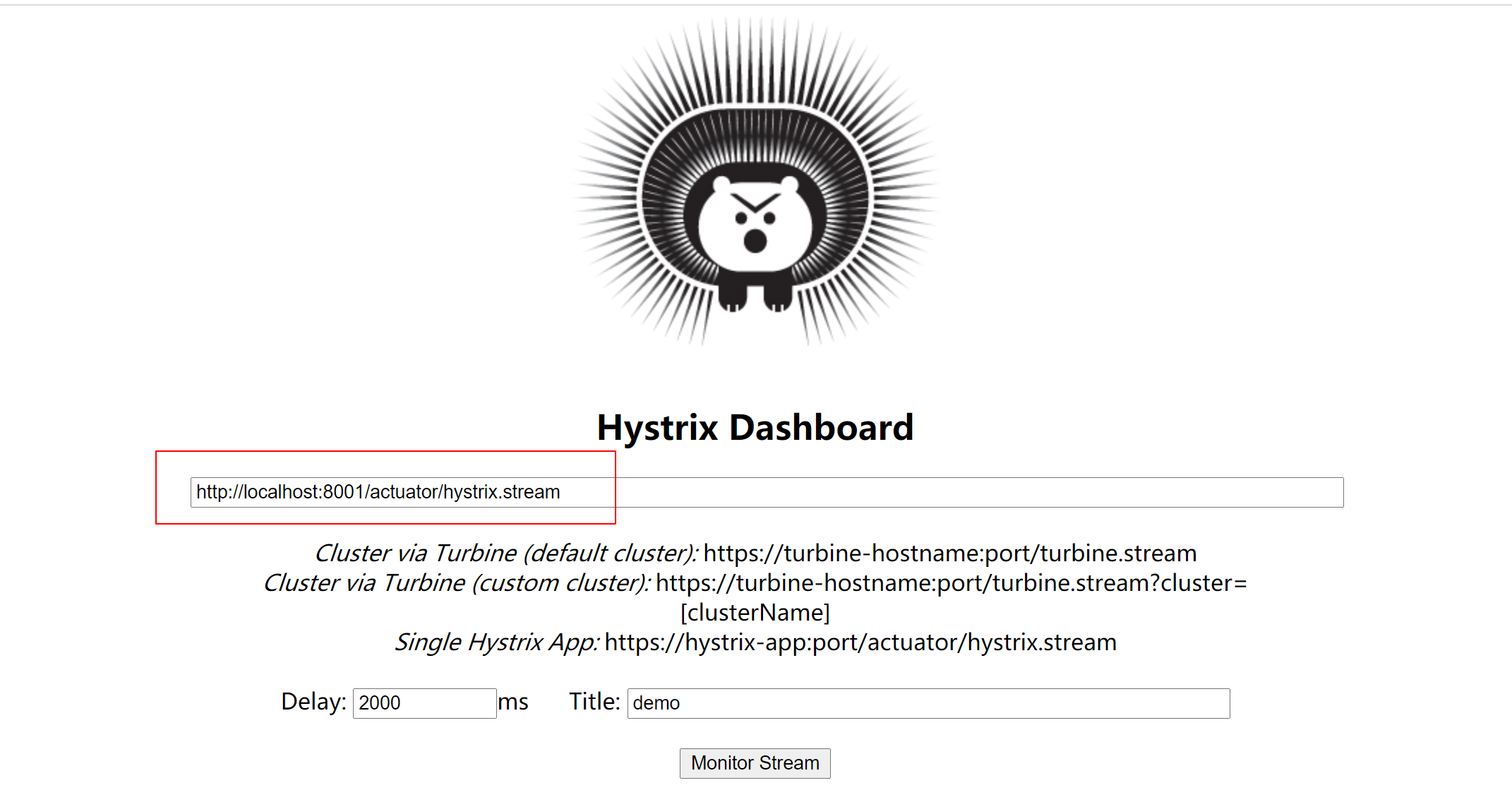
效果如图:

参数说明:

9. Zuul路由网关
官方文档:https://www.springcloud.cc/spring-cloud-dalston.html#_router_and_filter_zuul
9.1、什么是zuul?
Zuul 包含了对请求的路由(用来跳转的)和过滤两个最主要功能:
其中路由功能负责将外部请求转发到具体的微服务实例上,是实现外部访问统一入口的基础,而过滤器功能则负责对请求的处理过程进行干预,是实现请求校验,服务聚合等功能的基础。Zuul 和 Eureka 进行整合,将 Zuul 自身注册为 Eureka 服务治理下的应用,同时从 Eureka 中获得其他服务的消息,也即以后的访问微服务都是通过 Zuul跳转后获得。
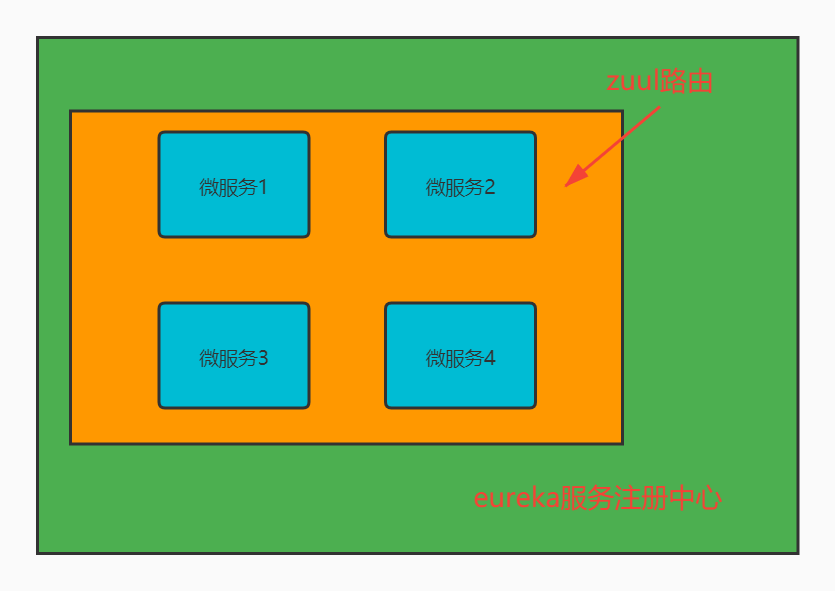
注意:Zuul 服务最终还是会注册进 Eureka。
9.2、入门案例
新建 springcloud-zuul 模块,并导入依赖
<dependencies>
<!--zuul-->
<dependency>
<groupId>org.springframework.cloud</groupId>
<artifactId>spring-cloud-starter-netflix-zuul</artifactId>
<version>2.2.8.RELEASE</version>
</dependency>
<!--hystrix-dashboard-->
<dependency>
<groupId>org.springframework.cloud</groupId>
<artifactId>spring-cloud-starter-netflix-hystrix-dashboard</artifactId>
<version>2.2.8.RELEASE</version>
</dependency>
<!--实体类-->
<dependency>
<groupId>com.lin</groupId>
<artifactId>springcloud-api</artifactId>
<version>1.0-SNAPSHOT</version>
</dependency>
<!--spring-web-->
<dependency>
<groupId>org.springframework.boot</groupId>
<artifactId>spring-boot-starter-web</artifactId>
</dependency>
<!--热部署-->
<dependency>
<groupId>org.springframework.boot</groupId>
<artifactId>spring-boot-devtools</artifactId>
</dependency>
<!--eureka-->
<dependency>
<groupId>org.springframework.cloud</groupId>
<artifactId>spring-cloud-starter-netflix-eureka-client</artifactId>
<version>2.2.8.RELEASE</version>
</dependency>
</dependencies>
application.yml
server:
port: 9527
spring:
application:
name: spring-cloud-zuul
#eureka 配置服务注册中心地址
eureka:
client:
service-url:
#注册中心地址7001、7002、7003
defaultZone: http://eureka7001.com:7001/eureka/,http://eureka7002.com:7002/eureka/,http://eureka7003.com:7003/eureka/
instance:
instance-id: zuul9527.com
prefer-ip-address: true
# actuator info配置
info:
user.name: linxiansheng
email: 20271@qq.com
#zuul
zuul:
#配置路由
#原本访问路由为: http://localhost:9527/spring-cloud-provider-dept/dept/queryById/1
#设置完后访问路由为:http://localhost:9527/mydept/dept/queryById/1
routes:
mydept.serviceId: spring-cloud-provider-dept
mydept.path: /mydept/**
# 设置忽略的服务,这里隐藏所有的服务
ignored-services: "*"
启动类:
@SpringBootApplication
//// 开启Zuul
@EnableZuulProxy
public class Zuul_9527Application {
public static void main(String[] args) {
SpringApplication.run(Zuul_9527Application.class, args);
}
}
测试,可以看到 zuul 网关已经被注册进来了:

经过 Zuul 路由网关配置后,访问的路由为:http://localhost:9527/mydept/dept/queryById/1

可以看到,微服务名称被替换并隐藏,换成了我们自定义的微服务名称 mydept,这样就做到了对路由访问的加密处理!
10. Spring Cloud Config 分布式配置
10.1、概述
分布式系统面临的–配置文件问题
微服务意味着要将单体应用中的业务拆分成一个个子服务,每个服务的粒度相对较小,因此系统中会出现大量的服务,由于每个服务都需要必要的配置信息才能运行,所以一套集中式的,动态的配置管理设施是必不可少的。spring cloud提供了configServer来解决这个问题,我们每一个微服务自己带着一个application.yml,那上百个的配置文件修改起来,令人头疼!
什么是SpringCloud config分布式配置中心?

spring cloud config 为微服务架构中的微服务提供集中化的外部支持,配置服务器为各个不同微服务应用的所有环节提供了一个中心化的外部配置。
spring cloud config 分为服务端和客户端两部分。
服务端也称为 分布式配置中心,它是一个独立的微服务应用,用来连接配置服务器并为客户端提供获取配置信息,加密,解密信息等访问接口。
客户端则是通过指定的配置中心来管理应用资源,以及与业务相关的配置内容,并在启动的时候从配置中心获取和加载配置信息。配置服务器默认采用 git 来存储配置信息,这样就有助于对环境配置进行版本管理。并且可用通过git 客户端工具来方便的管理和访问配置内容。
spring cloud config 分布式配置中心能干嘛?
- 集中式管理配置文件。
- 不同环境,不同配置,动态化的配置更新,分环境部署,比如 /dev /test /prod /beta /release。
- 运行期间动态调整配置,不再需要在每个服务部署的机器上编写配置文件,服务会向配置中心统一拉取配置自己的信息。
- 当配置发生变动时,服务不需要重启,即可感知到配置的变化,并应用新的配置。
- 将配置信息以 REST 接口的形式暴露。
10.2、spring cloud config 分布式配置中心与 Gitee 整合
10.2.1、服务端配置
新建 springcloud-config-server-3344 模块,添加依赖
<dependencies>
<!--config-->
<dependency>
<groupId>org.springframework.cloud</groupId>
<artifactId>spring-cloud-config-server</artifactId>
<version>2.2.8.RELEASE</version>
</dependency>
<!--spring-web-->
<dependency>
<groupId>org.springframework.boot</groupId>
<artifactId>spring-boot-starter-web</artifactId>
</dependency>
</dependencies>
application.yml:
server:
port: 3344
spring:
application:
name: spring-cloud-config-server
#连接远程仓库
cloud:
config:
server:
git:
#https,不是ssh
uri: https://gitee.com/xiaoshengstudy/spring-cloud-config-demo.git
启动类:
@SpringBootApplication
//开启 config server
@EnableConfigServer
public class ConfigServer_3344Application {
public static void main(String[] args) {
SpringApplication.run(ConfigServer_3344Application.class, args);
}
}
将本地 git 仓库 springcloud-config-demo 文件夹下新建的 application.yml 提交到码云仓库:

springcloud-config-demo 的 application.yml 配置如下:
spring:
profiles:
active: dev
---
spring:
profiles: dev
application:
name: spring-cloud-config-dev
---
spring:
profiles: test
application:
name: spring-cloud-config-test
HTTP 服务具有以下格式的资源:
/{application}/{profile}[/{label}]
/{application}-{profile}.yml
/{label}/{application}-{profile}.yml
/{application}-{profile}.properties
/{label}/{application}-{profile}.properties
测试访问 http://localhost:3344/application-dev.yml

成功访问配置文件。
10.2.2、客户端配置
将本地 git 仓库 springcloud-config 文件夹下新建的 config-client.yml 提交到码云仓库:
config-client.yml:
spring:
profiles:
active: dev
---
server:
port: 8201
#spring 配置
spring:
profiles: dev
application:
name: spring-cloud-provider-dept
#eureka 配置服务注册中心地址
eureka:
client:
service-url:
#注册中心地址7001、7002、7003
defaultZone: http://eureka7001.com:7001/eureka/
---
server:
port: 8202
#spring 配置
spring:
profiles: test
application:
name: spring-cloud-provider-dept
#eureka 配置服务注册中心地址
eureka:
client:
service-url:
# 注册中心地址7001、7002、7003
defaultZone: http://eureka7001.com:7001/eureka/
新建一个 springcloud-config-client-3355 模块,并导入依赖:
<dependencies>
<!-- config-client-->
<dependency>
<groupId>org.springframework.cloud</groupId>
<artifactId>spring-cloud-config-client</artifactId>
<version>2.2.8.RELEASE</version>
</dependency>
<!--spring-web-->
<dependency>
<groupId>org.springframework.boot</groupId>
<artifactId>spring-boot-starter-web</artifactId>
</dependency>
</dependencies>
resources 下创建 application.yml 和 bootstrap.yml 配置文件
bootstrap.yml 是系统级别的配置
#系统级别的配置,用于查找远程资源
spring:
cloud:
config:
#需要从git上读取的资源名称,不用后缀
name: config-client
profile: dev
label: master
uri: http://localhost:3344
application.yml 是用户级别的配置
#用户级别的配置
spring:
application:
name: spring-cloud-config-clietn-3355
创建 controller 包下的 ConfigClientController.java 用于测试:
@RestController
public class ConfigClientController {
@Value("${spring.application.name}")
private String applicationName;
@Value("${eureka.client.service-url.defaultZone}")
private String eurekaServer;
@Value("${server.port}")
private String port;
@GetMapping("/config")
public String getConfig() {
return "applicationName: " + applicationName +
"eurekaServer: " + eurekaServer +
"port: " + port;
}
}
启动类:
@SpringBootApplication
public class ConfigClient_3355Application {
public static void main(String[] args) {
SpringApplication.run(ConfigClient_3355Application.class, args);
}
}
启动服务端ConfigServer_3344Application 再启动客户端 ConfigClient_3355Application
访问:http://localhost:8201/config/

成功读取服务端的配置文件。
10.2.3、案例演示
spring-cloud-config-demo 新建 config-eureka.yml 并提交到码云仓库:
代码如下:
spring:
profiles:
active: dev
---
server:
port: 7001
# spring
spring:
profiles: dev
application:
name: spring-cloud-config-eureka
# eureka
eureka:
instance:
hostname: eureka7001.com # eureka服务端的实例名称
client:
register-with-eureka: false # 表示是否向eureka注册中心注册自己
fetch-registry: false # false则表示自己为注册中心
service-url: # 监控页面
defaultZone: http://eureka7002.com:7002/eureka/,http://eureka7003.com:7003/eureka/
---
server:
port: 7001
# spring
spring:
profiles: test
application:
name: spring-cloud-config-eureka
# eureka
eureka:
instance:
hostname: eureka7001.com # eureka服务端的实例名称
client:
register-with-eureka: false # 表示是否向eureka注册中心注册自己
fetch-registry: false # false则表示自己为注册中心
service-url: # 监控页面
defaultZone: http://eureka7002.com:7002/eureka/,http://eureka7003.com:7003/eureka/
新建 springcloud-config-eureka-7001 模块,并将原来的 springcloud-eureka-7001 模块下的内容拷贝的该模块。
1、清空该模块的 application.yml 配置,并新建 bootstrap.yml 连接远程配置:
#系统级别的配置,用于查找远程资源
spring:
cloud:
config:
#需要从git上读取的资源名称,不用后缀
name: config-eureka
profile: dev
label: master
uri: http://localhost:3344
2、在 pom.xml 中添加 spring cloud config 依赖:
<dependencies>
<!-- config-client-->
<dependency>
<groupId>org.springframework.cloud</groupId>
<artifactId>spring-cloud-config-client</artifactId>
<version>2.2.8.RELEASE</version>
</dependency>
<!--eureka-->
<dependency>
<groupId>org.springframework.cloud</groupId>
<artifactId>spring-cloud-starter-netflix-eureka-server</artifactId>
<version>2.2.8.RELEASE</version>
</dependency>
<!--热部署-->
<dependency>
<groupId>org.springframework.boot</groupId>
<artifactId>spring-boot-devtools</artifactId>
</dependency>
</dependencies>
3、启动类:
@SpringBootApplication
@EnableEurekaServer //eureka的启动类,可以接受别人注册进来
public class ConfigEurekaServer_7001Application {
public static void main(String[] args) {
SpringApplication.run(ConfigEurekaServer_7001Application.class, args);
}
}
4、测试
第一步:启动 ConfigServer_3344Application,并访问 http://localhost:3344/master/config-eureka-dev.yml 测试:
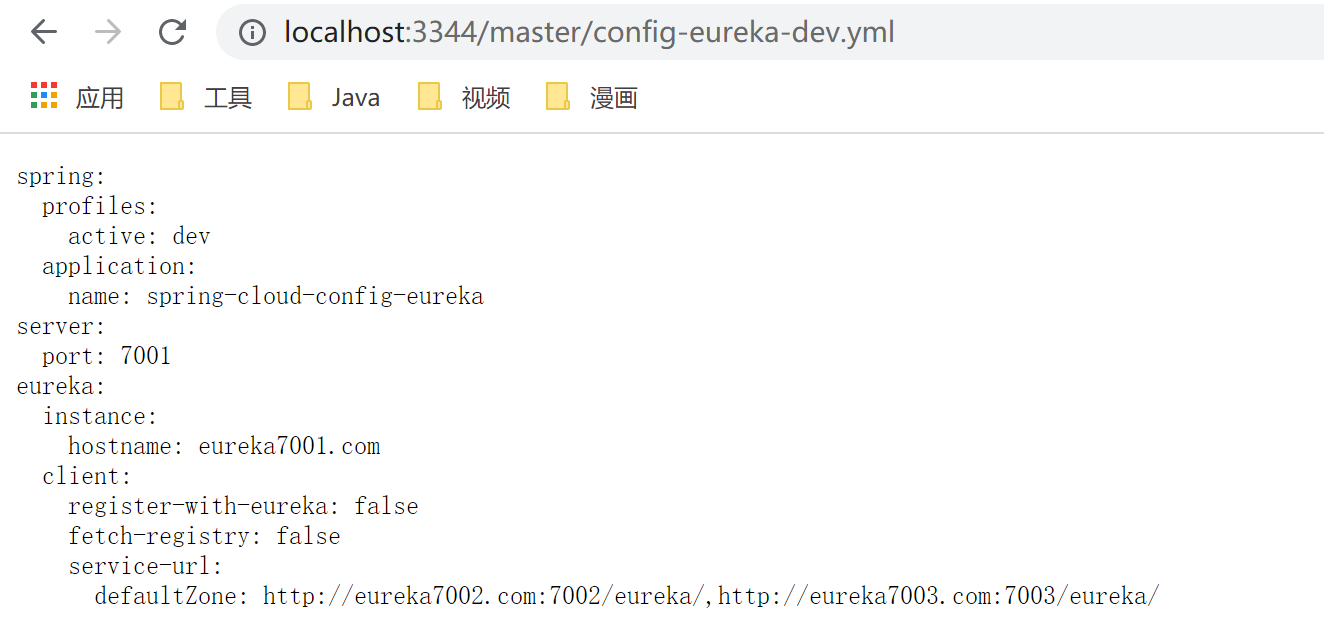
第二步:启动ConfigEurekaServer_7001Application,访问 http://localhost:7001/ 测试:

说明访问远程配置成功。
到这里 spring cloud 的搭建及基础模块的功能演示到这里结束了,积跬步,行千里。